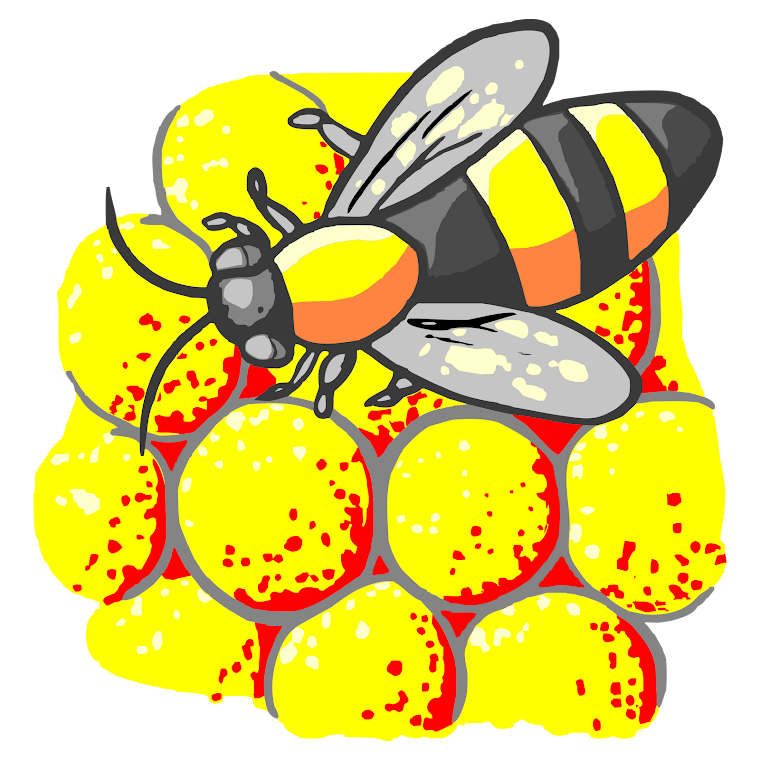LEBAH 10 - Mitologi Lebah 1
Bee (mythology)The bee, found in Ancient Near East and Aegean cultures, was believed to be the sacred insect that bridged the natural world to the underworld. Appearing in tomb decorations, Mycenaean tholos tombs were even shaped as beehives. Bee motifs are also seen in Mayan cultures, an example being the Ah-Muzen-Cab, the Bee God, found in Mayan ruins, likely designating honey-producing cities (who prized honey as food of the gods). dated to 7th century BCE (British Museum)
[edit] WorshipWorshipThe bee was an emblem of Potnia, the Minoan-Mycenaean "Mistress", also referred to as "The Pure Mother Bee".[1] Her priestesses received the name of "Melissa" ("bee").[1] In addition, priestesses worshipping Artemis and Demeter were called "Bees".[2] The Delphic priestess is often referred to as a bee, and Pindar notes that she remained "the Delphic bee" long after Apollo had usurped the ancient oracle and shrine. "The Delphic priestess in historical times chewed a laurel leaf," Harrison noted, "but when she was a Bee surely she must have sought her inspiration in the honeycomb."[3][4] Ernst Neustadt, in his monograph on Zeus Kretigenes, "Cretan-born Zeus," devoted a chapter to the honey-goddess Melissa. MythThe Homeric Hymn to Apollo acknowledges that Apollo's gift of prophecy first came to him from three bee maidens, usually identified with the Thriae. The Thriae was a trinity of pre-Hellenic Aegean bee goddesses. The embossed gold plaque (illustration above right) is one of a series of identical plaques recovered at Camiros in Rhodes[5] dating from the archaic period of Greek art in the seventh century, but the winged bee goddesses they depict must be far older. The Kalahari Desert's San people tell of a bee that carried a mantis across a river. The exhausted bee left the mantis on a floating flower but planted a seed in the mantis's body before it died. The seed grew to become the first human. In Egyptian mythology, bees grew from the tears of the sun god Ra when they landed on the desert sand. The bowstring on Hindu love god Kamadeva's bow is made of honeybees. LanguageBoth the Atharva Veda[6] and the ancient Greeks associated lips anointed with honey with the gift of eloquence: Achilles[7] and Pythagoras, it was said, had been fed on honey as infants, and the lips of Plato, Pindar,[8][9] and Ambrose of Milan were anointed with it.[10] The name "Merope" seems to mean "honey-faced" in Greek, thus "eloquent" in Classical times. Honey, "the gift of heaven" according to Virgil (Georgics, IV), even conveyed prescience: the priestess at Delphi was the "Delphic Bee", and in 1 Samuel 14 "Jonathan... put forth the end of the rod that was in his hand, and dipped it in a honey comb, and put his hand to his mouth; and his eyes were enlightened." Beekeeping was a Minoan craft,[11] and the fermented honey-drink, mead, was an old Cretan intoxicant, older than wine.[12] The proto-Greek invaders, by contrast, did not bring the art of beekeeping with them. Homer saw bees as wild, never tame, as when the Achaeans issued forth from their ship encampment "like buzzing swarms of bees that come out in relays from a hollow rock" (Iliad, book II). For two thousand years after Knossos fell the classical Greek tongue preserved "honey-intoxicated" as the phrase for "drunken."[citation needed] The bee is also seen in a number of Aegean and Near Eastern names. The Jewish historian Josephus noted that the name of the poet and prophet Deborah meant "bee". The same root dbr gives "word", "indicating the bee's mission to give the Divine Word, Truth", observes Toussaint-Samat.[13] Melissa is also similarly defined. SymbolismIn ancient Egypt, the bee was an insignia of kingship associated particularly with Lower Egypt, where there may even have been a Bee King in pre-dynastic times.[14] After the unification of Upper and Lower Egypt, this symbol was incorporated in the title usually preceding the throne name of pharaoh and expressing the unity of the two realms, He of the Sedge and of the Bee. Honey bees, signifying immortality and resurrection, were royal emblems of the Merovingians, revived by Napoleon.[15] The bee is also the heraldic emblem of the Barberini. A community of honey bees has often been employed by political theorists as a model of human society. This metaphor occurs in Aristotle and Plato; in Virgil[16] and Seneca; in Erasmus and Shakespeare and in Bernard Mandeville's Fable of the Bees, or Private Vices made Public Benefits,[17] which influenced Montesquieu and Marx. Tolstoy also compares human society to a community of bees in War and Peace. See also
Notes
References
External linksExternal linkshttp://en.wikipedia.org/wiki/Bee_%28mythology%29 |



Tidak ada komentar:
Posting Komentar